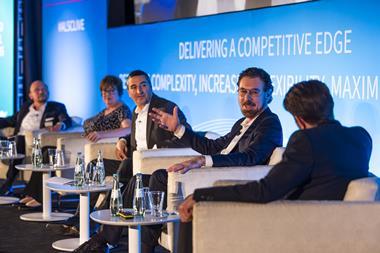More frequent launches and longer supply chains are placing significant pressure on manufacturers and inbound and outbound providers.
 Having spent tens of millions of dollars promoting the autumn 2012 launch of its 2013 model year Lincoln MKZ, Ford had high hopes for the vehicle, which was the subject of a huge marketing campaign, including Super Bowl advertising. Alas, those hopes had to be deferred and the advertising investment all but lost when deliveries to dealers were scaled back in the wake of parts shortages and production problems. Further delays came from the need to ship vehicles produced at Ford’s Hermosillo assembly line in Mexico to Detroit for detailed quality inspections before final customer delivery.
Having spent tens of millions of dollars promoting the autumn 2012 launch of its 2013 model year Lincoln MKZ, Ford had high hopes for the vehicle, which was the subject of a huge marketing campaign, including Super Bowl advertising. Alas, those hopes had to be deferred and the advertising investment all but lost when deliveries to dealers were scaled back in the wake of parts shortages and production problems. Further delays came from the need to ship vehicles produced at Ford’s Hermosillo assembly line in Mexico to Detroit for detailed quality inspections before final customer delivery.
It was a drastic measure, but one deemed necessary to avoid the embarrassing problems that dogged earlier launches of the company’s Fusion and Escape 2013 models, which included faulty fuel lines regarded as capable of causing a fire. In all, it was to be six months before Lincoln MKZ vehicle volumes reached planned levels, with Ford reportedly mulling an expensive relaunch to signal an end to its difficulties with the model.
All of which serves to highlight the fact that for any manufacturer, new vehicle launches can stress and challenge inbound and outbound supply chains in unexpected ways, placing heavy loads on parts suppliers, freight links, plant operations, quality inspectors and vehicle shipment facilities. At their worst, as Ford and many other manufacturers have discovered, those stresses and challenges can be significant enough to affect launch schedules.
While a carmaker’s production and quality functions have their own issues as they master the intricacies of building and inspecting a new model, logistics operations are also uncomfortably exposed. “Logistics issues are usually accountable for 30% of the delays in automotive product launches, and represent up to 10% of its costs,” says Fathi Tlatli, president of the automotive sector within DHL’s Customer Solutions and Innovation division. “Launch after launch, we see a spike in expedited freight, special charters and other exceptional – and costly – measures.”
The logistics function must, after all, orchestrate the inbound delivery of parts, while many suppliers struggle with their own new-model challenges. Likewise, the logistics function has to orchestrate the flow of manufactured vehicles to dealers to support marketing and launch schedules decided months in advance. That’s before taking into consideration complications like transporting demonstration vehicles to motor shows and dealer previews.
 "Logistics issues are usually accountable for 30% of the delays in automotive product launches, and represent up to 10% of its costs. Launch after launch, we see a spike in expedited freight, special charters and other exceptional – and costly – measures"
"Logistics issues are usually accountable for 30% of the delays in automotive product launches, and represent up to 10% of its costs. Launch after launch, we see a spike in expedited freight, special charters and other exceptional – and costly – measures"– Fathi Tlatli, DHL Customer Solutions and Innovation
These challenges have always existed for the automotive supply chain, but the industry has entered a phase of shorter and more aggressive launch cycles. According to IHS Automotive, there will be around 37 launch programmes in North America during 2014 and about 220 between now and 2020, an almost unprecedented pace. On top of that, a high number of assembly lines in North America – even those in parts of Europe, despite the prolonged downturn – are running three shifts, seven days a week. That output raises the issue of supply and logistics bottlenecks and the role that logistics providers can play, whether in the form of special launch services or by participating in more advanced planning.
The hard and the soft for outbound logistics
On the outbound side, the vehicle logistics challenges are clear enough. Toyota Motor Sales USA (TMS), for instance, differentiates between ‘hard’ vehicle launches – the launch of a brand new or significantly enhanced vehicle – and ‘soft’ launches, which are normally for mid-lifecycle model year changes and vehicles with minor ‘refresh’ enhancements.
“A soft launch typically requires no special transportation priority, and new production vehicles are allowed to flow through the normal supply chain,” explains Brian Mason, national strategic planning manager at Toyota Logistics Services, the outbound arm at TMS. “A hard launch typically requires a set number of new vehicles to be physically delivered to all dealers nationwide, usually with a 24 to 72-hour time window.” It’s this one-to-three day window, he adds, that is likely to cause the most disruption to existing logistics flows.

That said, he notes, the disruption associated with a model launch has to be balanced against the commercial benefits that a new model delivers. “We’re always mindful that while hard product launches can sometimes impact the logistics network, they are also an integral component of a successful product sales and marketing strategy,” he sums up. “We work hard to provide information and education to our sales and marketing groups to help them understand both the benefits and the operational and cost implications of choosing a hard launch scenario.”
Higher utilisation, but lower flexibility
Take a look at inbound logistics, though, and industry observers are less sanguine about the disruption caused by new model launches – not least because the perceived effects seemingly last for much longer than the initial three-day delivery window (plus associated recovery period) cited by Toyota's Mason. Indeed, there is a sense that the pain caused by new model launches is becoming a semi-permanent feature of the industry.
That is at least partly because the financial crisis and ensuing recession saw capacity shuttered, and with that capacity went the flexibility that helped the automotive industry cope with new vehicle launches.
“Carmakers and automotive suppliers both took a hit during the recession, and consequently cut back on resources; as vehicle sales have recovered, it’s put a strain on the supply chain,” notes Jeff Kosloski, group director of customer logistics in the automotive, aerospace and industrial division at Ryder System. “The recovery is good news, but the fact is that there isn’t the capacity that there was four or five years ago. When problems arise, they throws thing into a tail spin.”
Those problems – and the difficulty of recovering from the consequent tail spin – shouldn’t be underestimated, stresses Scott Grady, senior vice-president of corporate sales solutions at logistics service provider Landstar.
“We have one tier one customer with a tier two supplier supplying multiple tier ones that is struggling to keep up with demand,” he says. “It’s not a problem that we had prior to the recession; if they hit any production problems, then they will cancel the scheduled pickup, but if they defer a 4pm milkrun pickup to 6pm, there’s no way we can catch up if we wait. The shipment has to be by expedited freight, which adds cost and causes problems at the receiving dock.
“At another tier two, which is four months into a new product launch, the scheduled single shipment each day has been replaced by three or four shipments – each at a premium, because the assembly plant needs the product – but as the supplier is currently running seven days a week, there’s no opportunity to catch up.”
Grady adds that carriers are similarly constrained in their post-recession ability to recover from adversity. Landstar, for example, does not have spare trucks on standby; if it misses a pickup, that results in an expedited shipment at premium rates. Day-to-day problems with shipments are expected, he adds, but a new product launch exacerbates them.
“Today, with plants running at maximum output, those problems are worse,” Grady emphasises. “Post-launch, there’s a continual need to re-plan the routes and re-plan the docks. With the frequency of model launches that we’re seeing at the moment, that process of re-planning and adjustment becomes almost continual.”
Frequency, costs and global platforms
Many in the automotive industry have faced up to the uncomfortable realisation that issues surrounding new vehicle launches are not getting any easier, but there’s also a distinct possibility that they’re becoming more serious.
“New vehicle launches have always been stressful, but what has changed is the frequency of launches,” says 35-year automotive industry veteran Jens Möller, senior vice-president for automotive at UTi Worldwide. “Longer supply chains add to the problem. Post-launch, the rate of engineering change is always higher, raising the risk that in-transit inventory can suddenly become obsolete, requiring expedited shipments via air freight to recover.”
Automotive analyst Michael Robinet, managing director of IHS Automotive consulting, agrees. “The industry has always had launch issues,” he notes, “but they’re more pervasive now. Manufacturers are pushing things closer to the limit in terms of model launches; cost-down pressures are seeing more global sourcing and more global platforms, which add to the logistics challenges. There are more resource constraints in the supplier base and the rate of change in automotive manufacturing technologies, such as joining and bonding, is truly breakneck.”
In isolation, he admits, each of these developments is largely to be welcomed as a sign of progress – a slimmed-down industry is rolling out more new models than ever, adopting practices such as global sourcing, global platforms and new assembly technologies to drive costs down – but the side effects of such developments aren’t always benign. New model launches, which cause change and dislocation in the supply chain, bring these impacts into sharp focus.
“As the industry moves to having fewer, but global platforms, more and more of the global automotive industry is being forced to march at the same pace,” says Robinet. “One result is that it’s pushing complexity out into markets such as Brazil and India that might not be ready for it. Another is that in the short term, we’re going to see more product launches – despite the issues that they bring – as platform cycles move to become synchronised.”
As Bloomberg noted in December 2013, worries over the pace of model launches are even starting to impact carmakers’ stock prices, as their costs are making investors nervous. Ford, for instance, plans to introduce 23 new vehicles globally in 2014 – more than double its 2013 total – but with costs mounting as revenue growth stalls, the carmaker had no choice but to warn stock markets last year of a likely fall in pre-tax profits. And even that’s assuming there is no repeat of the problems with the earlier launches.
“A public admission of a vehicle launch delay, or reduced vehicle production on a popular model, sends the stock price of tier one manufacturers and carmakers into a tumble,” notes Kerry Zielinski, vice-president for business development at Ceva Logistics. “A launch that delays a product will show up in metrics and in the press, with the assumption that revenue may be lost. We do not live in a patient marketplace.”
Planning launch logistics
While the pace and complexity of model launches have increased, supply chain managers tend to agree about what needs to be done to ease the pain they cause. Ryder’s Kosloski, for instance, points to a growing understanding of the need to better plan inbound parts flows.
“We’re seeing a growing acceptance by automakers that a more formal launch planning process can help reduce the adverse impacts of vehicle launches,” he says. “They’re seeing that putting effort into better planning can have a very positive outcome. From a logistics perspective, having a better handle on production forecasts, the ramp-up schedule, where suppliers are located and any packaging stipulations, can make a real difference. Something as simple as how parts are put on a vehicle can have a considerable impact on the number of parts carried and the ergonomics of loading and unloading.”
Similarly, on the outbound side, timely planning can also make a difference, says Jan Bures, executive vice-president of group aftersales and services at Volkswagen Group of America. Volkswagen, he explains, has a formal planning process that calls for early decisions on questions such as export markets, transport routes to market and the likely ratio of built-to-order versus built-to-forecast production.
“Such questions can have a considerable impact on issues such as storage capacity, transport modes, transport capacity, and customs capacity,” he notes. “So it’s important to decide these things early on and think through the logistics issues, otherwise you might find that either you can’t supply certain markets, or that you can supply them only at a significantly higher cost.”
Toyota’s Mason agrees that thorough planning and advance communication help minimise launch challenges. “Setting appropriate expectations is important, as it is unanticipated impacts to vehicle deliveries that usually generate the most concern during a launch process,” he says.
Consequently, some logistics providers are seeing an opportunity to help carmakers better plan vehicle launches. DHL, for instance, has introduced a three-stage modular service for launches, which aims to cover the entire cycle from prototype to flying demonstration models to motor shows, and reduce the supply chain incidents that can dog a launch.
 "It’s important to think through the logistics issues, otherwise you might find either you can’t supply certain markets, or you can supply them only at a significantly higher cost"
"It’s important to think through the logistics issues, otherwise you might find either you can’t supply certain markets, or you can supply them only at a significantly higher cost"- Jan Bures, Volkswagen Group of America
“Overall, the opportunity is for smoother vehicle launches, less costly launches and less risky launches,” says DHL’s Tlatli. “The challenge is equally clear: to design the supply chain proactively, rather than responding reactively.”
The main objective, he explains, is to get logistics issues thought through earlier. Traditionally, logistics has been involved very late in the process. Tlatli believes that by taking advantage of opportunities to design supply chains in a slightly different way, including more consideration for risk, sourcing and integrating transport modes, costs and delays in launches can be greatly reduced.
At Ryder, too, Kosloski says, new service offerings aim to help carmakers deliver smoother and less costly new model launches, such as advanced network planning of material sourcing; lifecycle logistics costing; and redesigning supply chains as launch volumes accelerate.
“Today, we’re embedding some of our supply chain and logistics engineers in customers’ launch teams, helping them to plan launches,” he sums up. “We also have people on site at customers’ headquarters, sometimes two years ahead of a launch. Five years ago, we didn’t offer any of this as a service. Now, there’s a real need, and we do.”






















